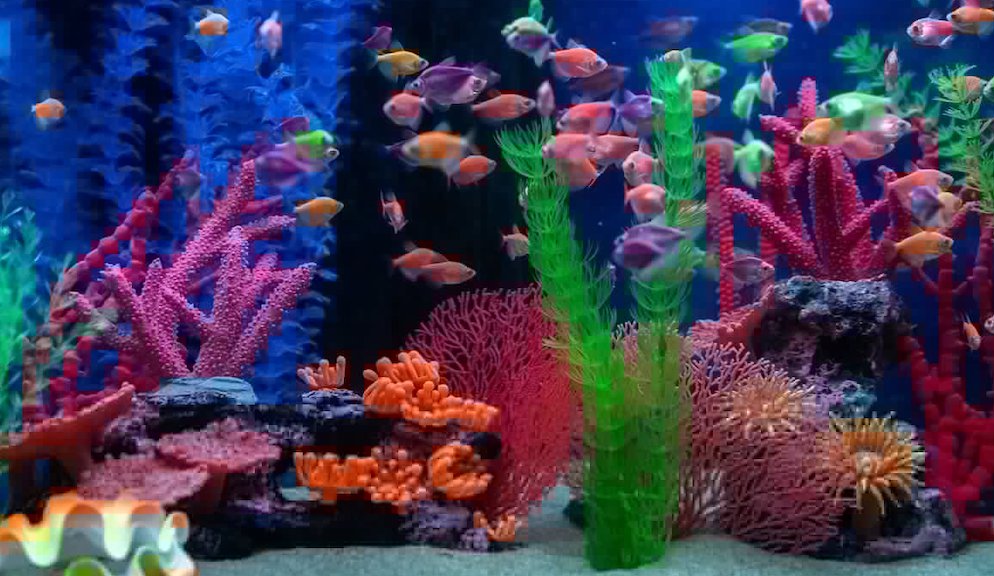
Keeping a fish as a pet is a very freshening choice to ornate one’s home and also help complete a home. In the USA, over 10 million households have freshwater fish as pets and making it no surprise that they are one of the top choices of pets.
With so many different fishes to choose from, the task of selecting the right fish can be quite daunting. But have no fear, this article will identify some of the more popular choices used in a freshwater aquarium and give some insight on how to best accommodate them. Most of these exceptionally bright and colorful freshwater fish can contribute to an exciting display aquarium. They are adorable creatures and can also become a significant part of one’s tank.
1) Neon Tetra (Paracheirodon innesi)
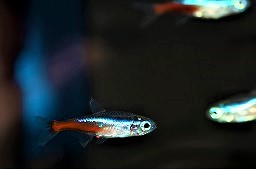
This little freshwater aquarium fish is native of South America and is a part of the Characidae family. Famous for its dynamic behavior and bright and dazzling colors, they are best identified by the iridescent blue horizontal stripe that runs across their body, making it visible in dark waters.
It is one of the more popular fish amongst fish keepers as they are effortless to take care of this fish. They can live for around ten years, and they can grow to approximately 1 to 1.5 inches in size.
These fishes can be a little bit skittish. They are most comfortable when they are a part of a small school (3 to 6 members) and have enough hiding spots in the tank. It will encourage them to feel confident enough to make their presence known within the tank.
These fishes are omnivores and eat most foods like shrimp, worms, insects, brine, and plants.
2) Discus Fish (Symphysodon aequifasciatus)
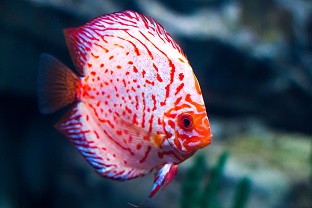
These freshwater fish are famous for their distinctive shape and bright colors. They come in a variety of patterns and easily identified with their unique red irises. They are a popular choice for freshwater aquariums.
They can reach about 8-10 inches; therefore, a larger tank is required for them, at least 25 gallons. They need a higher temperature than other fishes, with temperatures set around 84-87°F, and water should be clean with frequent water changes.
They can have tankmates of other fishes that need the same water conditions, as long as these fishes are not aggressive.
With a Discus fish, make sure to incorporate a plant in the aquarium. The plants that are selected should be tolerant of the high temperature as Discus are tropical freshwater fishes and require warmer water, and Anubias plant is a great choice.
Discus are carnivores by nature. Their diet consists of blood worms and beef heart supplemented with flakes to provide minerals and vitamins.
3) Killifish (Austrolebias affinis)
Killifish is one of the more vibrantly neon-colored and beautifully patterned freshwater aquarium fish. The upkeep level of these fishes varies from easy to severe, all dependant on the species.
Generally, these fishes are peaceful and strive well in community tanks with other small, non-aggressive, and other like-mannered fish. But it is highly recommended to have only one male species as males are aggressive towards each other.
Killifish have a lifespan of around five years and are approximately 2.9 cm in size. The tank requirements are a minimum of 20 gallons of water with a temperature of 72- 75 °F.
They are pike-shaped and slender. The presence of large dorsal and anal fins makes them great swimmers.
Most of these fishes are carnivores and enjoy a diet of worms, crustaceans, and insect larvae.
4) Kuhli loach (Pangio kuhlii)
A native of southeast Asia, it is an eel-resembling fish and can be housed in freshwater tanks with a temperature of 76-86°F. The resemblance is not only in terms of size and looks. However, they “imitate” the behavior of real eels.
It is an attractive eel looking type of fish and comes in a variety of hues with different color patterns.
These are peaceful species that like to hide during the day but are active at night. However, when housed with other species, they are more active in the daytime because of food rivalry. They are around 4-5 inches in size and can live approximately ten years. The fish prefer to live in a school of 5-6 fishes.
They are bottom feeders and great tank cleaners, which means they can eat a variety of both frozen and live food that will fall to the bottom of the tank. Granules, pellets, brine shrimp, different tablets, blood worm, daphnia, tubifex, and other things which they can dig or find at the bottom are all part of their diet.
5) Angelfish (Pterophyllum)
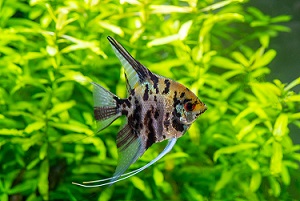
These fish are native of South America and belong to the same family of Cichlid as Oscars, Discus, and Parrot Fish. It behaves as cichlids do, especially when reaching adulthood, become aggressive, and get territorial.
They can reach sizes around 6.2 inches long and 8.2 inches tall, and they feel most comfortable in slightly larger tanks (at least 29-gallons) with a water temperature of 74– 83°F. Plants give them a place to hide and rest, helping to provide them with a feeling of security.
So, it is a great choice to have plants when housing them. They are carnivores by nature, so pellets, flakes, daphnia, and shrimps are suitable as their well-being diet.
6) Oscar Fish (Astronotus ocellatus)
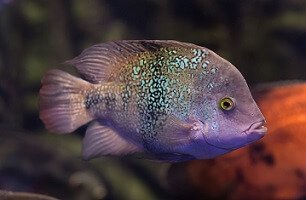
These fish are native of South America and belong to the family of cichlid. These fish are favorable to keep for an aquarium. They are intelligent aquarium fish and has trained to do tricks.
They can reach 35 cm and can live for approximately ten years. Since the body size of these fishes is quite large, they need a 30-gallon tank or larger for better care. The Oscar needs clean water with temperatures ranging from 74-81°F to strengthen their immune system and help prevent the spread of many diseases.
These fish require a lot of maintenance because of their carnivorous nature and the amount of waste they generate.
7) Flowerhorn cichlid (hybrid species)
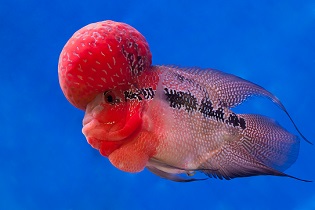
It is a one of a kind cichlid hybrid that is selectively bred by fish keeping enthusiasts and is a human-made species.
It is an ornamental aquarium fish that immediately catches the eye because of their stunning colors and their uniquely shaped heads, after which as per its name. It is among the most colorful cichlid fishes.
Typically, they are around 12 inches, but some can reach approximately 16 inches. Their size varies depending upon the hybrid species and surprising it can live for nearly 12 years. Because of their big size, they require huge tanks with a minimum of 70-gallon tank with water temperatures in the range of 82-86°F.
They need plenty of space and are territorial.
Conclusion
Here were some types of freshwater fish that will be ideal for an aquarium. But remember before getting the right fish, make sure you search for the information to take good care of them. Fish are reflective of their environment. A happy fish will show off their pretty colors more and also develop fun personalities.








